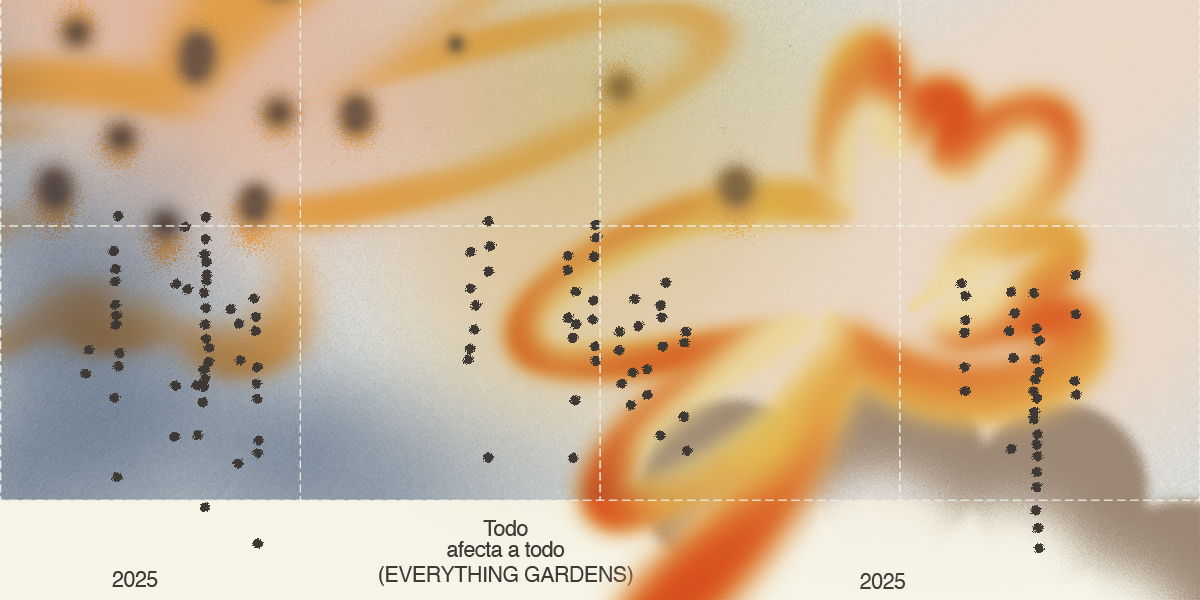everything affects everything
(everything gardens)

Everything Gardens is a principle of permaculture that refers to the idea of how in nature each being, element or system interacts with its environment and modifies or influences it in some way. Everything affects everything. An insect that pollinates a flower, the wind that disperses seeds, a plant that releases nutrients to the soil or the fungus that decomposes matter.
The same thing happens in an institution, where there are no neutral decisions or isolated elements, where any change or choice, no matter how small, inevitably affects others. That is why we think of the institution as an ecosystem. As Rudolf Steiner defined it, a 'community of living organisms in conjunction with the non-living components of their environment, interacting as a system'. The people who work in the centre, the furniture, the insects, plants or the alarm system: we are all interconnected and we all affect each other. Understanding ourselves as interdependent beings on a planet with finite resources helps us become aware of the impact our actions have and how we relate to our environment.
To help us put this co-responsibility into practice we have outlined some fields which are the framework of thought, values and intentions that nourishes and shapes everything that takes place at La Escocesa. The fertile land from which public activities are generated, but also the soil that shows us the path and direction in case of doubts, conflicts or disorientation. These fields are alive, they interact and sometimes their roots expand and entangle. We feel that after the fallow period, the land has been oxygenated, removed and fertilised. We have been able to plant some seeds, but always through active listening and constant dialogue with our environment, with the desire to shorten the distance between the talk and the action, assuming the risk of making mistakes and the will to learn from them.
These fields are commitments to us and to our context. They are long-term analysis and work processes: internal training, work groups, protocols and prototypes. They are actions and experiences that become praxis and that in many cases are not translatable into words. During the next few months we will work on drafting an intersectional manual that intends to structure and make visible the governance, values, ethics and ways of doing at La Escocesa.
How do we incorporate tools of restorative and transformative justice and collective responsibility in resolving our conflicts?
We understand that the feminisms They are plural, complex and sometimes contradictory, and are situated at the intersection and in the search for alliances with anti-ableism, environmentalism, class struggle and anti-racism. During 2024 we will work on the review of the current feminist protocol of La Escocesa from an intersectional perspective and sexual and gender diversity.
How can a cultural institution attend to the health of diverse bodies?
This growing area wants to take care of the well-being of the bodies from the questioning of the hegemonic logics that mark the limits between health and illness. It seeks to put bodies at the center, taking into account their diversity and understanding that there is no single way to communicate, move and relate.
How can sustainability and climate justice criteria be applied within the artistic institution?
We understand that it is our responsibility not only to minimize the ecological footprint but also to work on the transition towards non-extractive systems and relationships that include forms of reparation. Likewise, we try to consider the environmental impact of planned artistic activities and events, opting for more sustainable options in terms of transport, logistics and supplies. Within this framework of ecosystem transition, we also try to distribute resources in initiatives and projects that promote sustainability, climate justice and biodiversity.
How can a white institution like La Escocesa be anti-racist?
ANDRacism is a problem rooted in our society, in our institutions and systems, including the artistic field, and that is not always visible. Addressing it involves recognizing and challenging inequalities and prejudices, as well as promoting equity and diversity, but to do so we must begin by critically examining policies, practices and privileges that operate within the institution itself. Understanding and dismantling the framework of structural racism of which we are part is our responsibility, as well as supporting projects and practices that work from the antiracism.
How can we open La Escocesa governance code so that it can be replicated by other groups and institutions?
He model of governance de la Escocesa is far from the more hierarchical and rigid structures that usually govern contemporary art and cultural centers. Given the clear lack of references of institutional projects in the field of culture that put real community management into practice and knowing that this model has been outlined and implemented successfully for a decade and that it forms a clear example of how culture can be managed collectively.